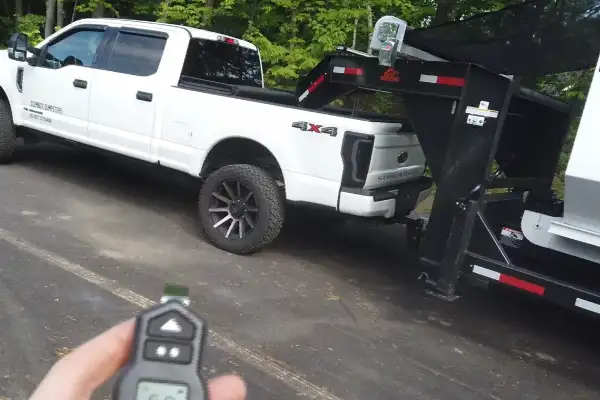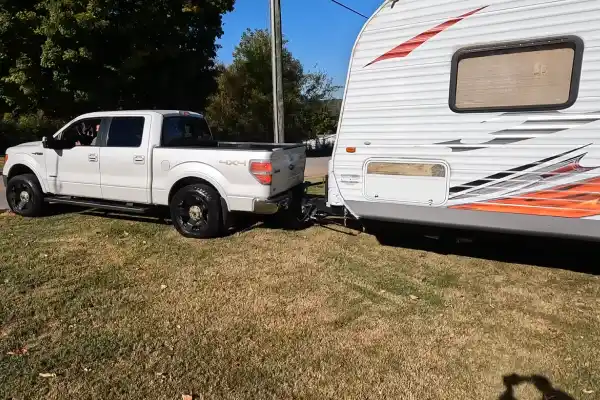Truck squat, also known as truck sag, is common when towing heavy loads or hauling payloads. This visible effect of payload on the rear end axle causes the front of the vehicle to lift while the rear end tilts downward. And without fixing the issue, it compromises the truck’s stability and becomes a potential danger.
You must ensure proper weight distribution by placing heavier items towards the front of the trailer and evenly distributing the load. Consider using a weight distribution hitch to help evenly distribute the weight between the truck and trailer. You can install air suspension systems to improve the truck’s towing capacity.
Here, we’ll explain how to fix that sagging rear end and keep your truck in top shape while hauling heavy loads. Get practical tips and techniques to maintain your truck and prevent squatting, ensuring a smooth and balanced towing experience.
How to Fix Truck Squat When Towing: Tips to Balance Your Load

Towing a trailer can strain your truck, causing it to squat or sink down in the rear end. To fix truck squats when towing, there are only four tips you can follow.
- Tip 01: Proper weight distribution
- Tip 02: Invest in weight distribution hitch
- Tip 03: Consider air suspension systems
- Tip 04: Upgrading leaf springs
Tip 01: Proper Weight Distribution
Maintain proper weight distribution by keeping the tongue weight of the trailer within the recommended range of 10 to 15% of the loaded trailer weight.
To do this, carefully consider the placement of your trailer. If the tongue weight is too light, the truck’s rear will sag, causing the truck to squat. Conversely, when the tongue weight is too heavy, it can cause the front of the truck to lift, affecting steering and braking.
So, weigh your fully loaded trailer and calculate the recommended tongue weight. Moving heavier items closer to the front of the trailer if necessary, as a commercial tow truck service typically does.
Tip 02: Invest in a Weight Distribution Hitch
A weight distribution hitch helps distribute the weight of your trailer evenly across all axles, reducing the strain on your rear suspension. It’s important to adjust the hitch correctly to achieve optimal weight distribution. Different types of towing hitches can also be utilized to fine-tune the weight distribution further.
Tip 03: Consider Air Suspension Systems
When using an air suspension system to fix truck squats when towing, you must properly adjust the air pressure in the airbags. This adjustment will maintain a level ride and optimal tire contact with the ground.
Start by inflating the airbags to the minimum recommended pressure and then gradually increase it until the truck sits level when loaded. It’s essential to avoid overinflating the airbags, as this can lead to a harsh ride and potential suspension damage.
Tip 04: Upgrading Leaf Springs
Consider upgrading your leaf springs to support your rear suspension to address truck squat when towing. Truck squats can be effectively combated by replacing the existing leaf springs with heavy-duty ones specifically designed for towing.
These upgraded leaf springs are built to handle the extra weight and provide improved stability and control while towing heavy loads. Your truck’s rear suspension is strengthened to distribute weight more evenly, reducing downward force on the rear and minimizing squat.
How Do You Maintain Your Truck to Prevent Squatting?
For maintaining your truck and preventing squatting, there are several key steps you need to follow.
i. Regular Maintenance
Start by inspecting the shocks for signs of leakage or damage. Worn-out shocks can cause the rear end of your truck to sag and contribute to squatting.
Also, check the bushings and control arms for any signs of wear or damage. These components help maintain proper alignment and stability; if worn out, they can contribute to squatting.
Replace any worn-out suspension components promptly to ensure your truck is in optimal condition for heavy duty towing service and prevent squatting.
ii. Check Your Tires
Proper tire maintenance is essential for ensuring optimal performance and stability. Underinflated tires can lead to increased squatting as they struggle to support the weight of the load.
Aside from that, ensure your tires are balanced and aligned correctly. Misaligned tires can cause uneven weight distribution, exacerbating the squatting issue.
Maintain tread depth and overall tire condition regularly to minimize the risk of squatting due to worn or damaged tires.
iii. Avoid Overloading
Maintain your truck to prevent squatting by not overloading it beyond its towing capacity or payload limit. Exceeding these limits can lead to excessive strain on the rear suspension, causing the truck to squat when towing.
To avoid overloading, always be aware of the maximum weight your vehicle can safely handle. This information can be found in your truck’s manual or by consulting the manufacturer’s specifications.
iv. Consider Professional Help
A professional mechanic or suspension specialist can provide valuable insights and expertise to help you maintain your truck and prevent squatting. They have the knowledge and experience to assess your towing setup and recommend the most suitable upgrades and adjustments.
Is sagging bad when towing?
Sagging can affect your vehicle’s braking performance by shifting the weight distribution and reducing the brakes’ effectiveness. It can cause the headlights to point higher, blinding oncoming drivers and reducing your visibility.
Your rear tires can be overstressed by sagging, resulting in tire wear and blowouts. When your vehicle sags, it is more likely to sway and cause an accident.
Therefore, you must address any sagging issues when towing to ensure the safety and performance of your vehicle.
Ensure Your Truck Is Squat-Free and Safe for Towing

Addressing truck squats when towing is not just a matter of aesthetics but an essential aspect of ensuring your vehicle’s safety, performance, and longevity. The causes of truck squats are multifaceted, ranging from excessive weight and uneven distribution to issues with hitches and suspension.
Maintaining your truck properly is crucial to prevent squatting while towing. Regularly checking the suspension, tires, and weight distribution can ensure a safe and stable towing experience. Consult a professional to ensure your truck can handle the weight and maintain a level stance.
Santa Clara Towing can provide you with the expert advice necessary for the towing service you need. They are located at 1361 Calabazas Court #2, Santa Clara, CA 95051, and are your trusted source for expert towing services in the Santa Clara area.
You can reach them via email at [email protected] or by phone at 669-228-5951, and they guarantee a response within 24 hours.
